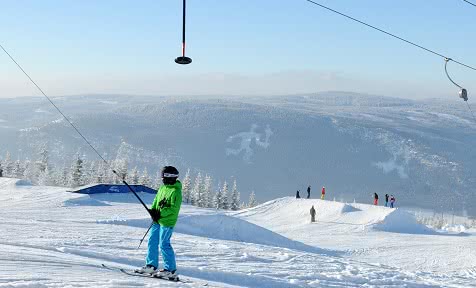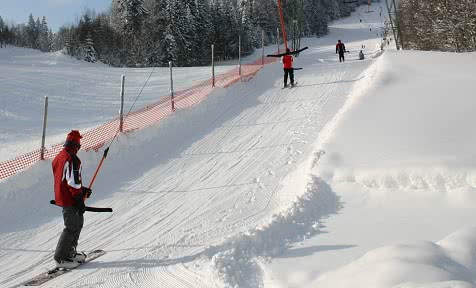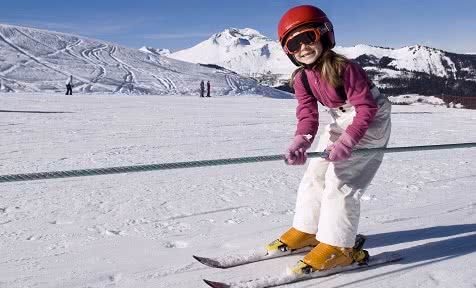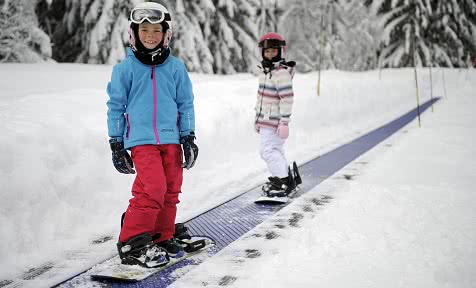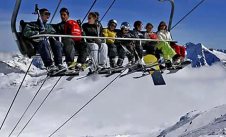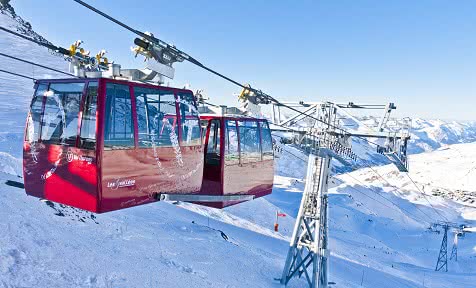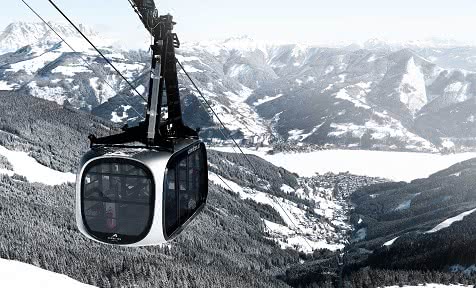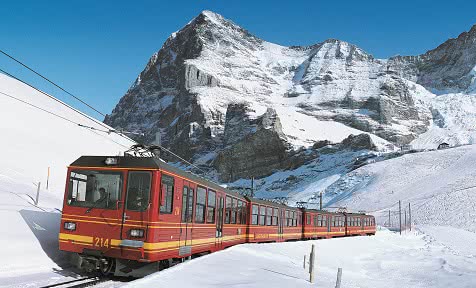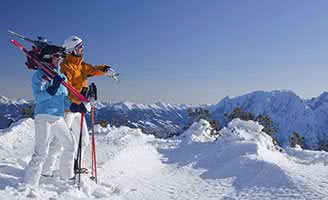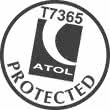Ski Lifts
Ski resorts have all kinds of different lifts that transport you around the ski area. They can be divided into three categories: first there’s surface or drag lifts, where you keep your skis or snowboard on the ground and are pulled or pushed up the slope. Aerial lifts take you off the ground, while railways go up track and often underground. If you follow the instructions of the lift operators and take note of any signs, they’re all safe and easy to ride.
You’ll need to buy a ski pass to use most lifts (though sometimes beginner lifts are free). Most resorts have a number of passes to choose between - one for the local area and others that cover adjoining resorts for access to more terrain. Usually lifts have a scanner which lets you through when you present your pass - swipe past the scanner and the turnstile will open for you.
Types of ski lift
Drag lifts/Surface lifts
Button/Platter lifts
(French: téléski, German: Schlepplift, Italian: Sciovia)
Button is the European word and you’ll hear Platter used more over the pond… You might hear them called ‘Poma’ lifts after one of the main manufacturers. They consist of long poles with small round seats that are attached to a moving cable and are usually used when the distance doesn’t warrant building a chairlift.
How to use a button lift safely:
- Approach the loading area and put your poles in one hand. Look behind you so you’re ready to grab the button as it comes round, or wait for the liftie to hand it to you.
- Place the seat between your legs and allow it to pull you up the slope – don’t try and sit on it, keep your weight over your skis.
- Hold onto the pole with your hands and grip tightly.
- Keep your skis parallel to avoid veering off.
- Don’t get off before you reach the top as you’ll probably end up sliding backwards. If you do come off accidentally and don’t feel confident enough to ski down and get back on, try and get to a safe place so you don’t put the person behind you at risk. The lift operator will be looking out for occasions when this happens and can help you get back safely.
- When you get to the top, don’t let go to soon – check when the people ahead of you get off for an idea of when’s best.
How to use a button lift with a snowboard:
Button lifts can be a bit tricky for boarders as they’re designed to be ridden facing forwards. Release your back foot from its bindings before getting on so you can shuffle along. Keep your knees bent, your shoulders in line with the board and your weight on your front foot – this can help you stay balanced and lets you steer as you normally would. Drift out of the exit zone before reattaching your binding to leave space for the person behind you.
Rope tows
This is a continuous rope loop that pulls you along – they’re often used on long flat parts of a slope. They often don’t have a station; you just slide up and grab hold.
How to use a rope tow safely:
- When you reach a rope tow, grab it at the side of your body whilst holding your poles in one hand. Keep your gloves on to avoid rope burn and give you extra grip.
- Keep your skis parallel and let the rope drag you up the slope.
- Don’t try to ski away from the rope until you reach the end in case it causes you to fall or get in the way of others.
How to use a rope drag lift with a snowboard:
Either ride with the rope in front or behind you. Whichever way you opt for, point the board up the hill and grab hold. Keep your shoulders parallel to the board and just let it pull or push you along.
J bars & T-bars
These work in a similar way as a button lift, although the end is a J (for one person) or T (for two) shaped bar.
How to use J bars & T-bars safely:
- When in the loading area, put your poles into one hand and get ready to grab it as it comes round from behind you or the lift operator passes it to you.
- Instead of putting it between your legs, let the bar rest just below your bottom and push you up.
- It won’t hold your weight so don’t try and sit – let your skis take most of the weight.
- If you fall, try to move out of the pathway. If you can’t ski back down and rejoin the queue, a lift operator / instructor should be able to help you get back safely.
- Stay on the lift until you reach the point that you’ve seen the people in front let go.
How to use J bars & T-bars with a snowboard:
There are two main ways – it comes down to what you find most comfortable. Some choose to ride side-on with the bar resting under the back hip, and others ride it sideways with the bar between their legs. You can either ride with both feet strapped in or one unfastened – either way, keep your knees bent, weight on your front foot and shoulders in line with the board.
Magic Carpets
Magic Carpets or travelators are a conveyer belt built into the snow which transports you over a short distance. They’re often found in beginner areas as they’re the easiest lifts to use and work on gentle slopes. Some conveyers are covered (like the one in Val Thorens) so they look a bit like a tunnel whereas others are open (like in Zermatt where a covering would mean you miss the awesome views of the Matterhorn...).
How to use a Magic Carpet:
- Most magic carpets are fairly short, so you’re likely to be able to see if someone in front of you loses their balance (most often because their skis aren’t entirely on the carpet). If they do, don’t get on and you’ll avoid a pile up. Make sure you keep a safe distance from the person in front, or it’ll get backed up as you try to exit at the top. Some carpets have a stop and go light, so make sure the light is green before trying to get on.
- Shuffle onto the magic carpet with your skis in parallel. The belt is grippy so you don’t slide back down, which means you might feel an initial jolt as it takes over the movement – don’t try and fight it as you might become unsteady.
- Have your poles at the ready to push you away from the end of the lift so the next person has space to come off.
How to use a Magic Carpet with a snowboard:
Unfasten one foot and scoot to the loading area, then slide your board onto the belt, front foot first. Place your back foot on your board, or just to the side on the belt itself –make sure your foot is on the board before exiting so you can easily slide off.
Aerial lifts
Chair lifts
(French: télésiège German: Sessellift, Italian: Seggiovia)
These often make up the majority of lifts in a resort. Most seat 2 to 8 people and they run on a continuous wire. Some (called bubble chairs) come with a pod-like cover to shelter you from the elements while others have heated seats or a magnetic device fitted, so a child wearing the corresponding magnets can be safety secured. You’ll hear chair lifts referred to by the amount of people they can seat: like doubles, triples, quads or 5 packs, 6 packs, 7 packs and 8 packs.
How to use a chairlift safely:
- If you have one, take off your rucksack while you’re waiting in the queue (if it’s comfortable, the easiest thing to do can be to wear it on your front which leaves your hands free).
- When the liftie signals you to go through, put both poles in one hand and shuffle forward with your skis in parallel.
- Chairlifts are user operated; you have to pull the safety bar down over your head once you’re sat down.
- Sit in the right position so that when you pull the bar down it doesn’t trap any clothing or bash anyone on the head or leg. Check where the footbar is so you can rest your legs.
- Sit back on the seat and avoid having to shuffle about while you're in the air.
- Look out for signs that tell you when to raise and lower the safety bar - watch when the people in front of you lift theirs for an idea of when to act.
- When you come to ski off, lift the safety bar and ski off with your feet parallel (snowploughing in the exit zone can cause others to fall over you). Watch out for the seat which can bump your legs from behind if you don’t move off quickly.
How to use a chairlift with a snowboard:
Unfasten one foot so you can skate to the loading area. When you exit, put your back foot on the inside of your back binding and drift out of the exit path before you try to fasten your binding.
Gondolas / bubble lifts
(French: télécabine, German: Gondel, Italian: Telecabina)
Gondolas or bubbles are enclosed pods that run on a loop of wire. They come in a range of sizes: in smaller ones you have seats and can store equipment on the outside, in larger ones you take your gear in with you and stand or sit around the edge. Gondola’s are getting more and more hi-tech, Val Thorens invested a whopping €6.5 million in the Funitel Thorens recently and the Jandri Express in Les 2 Alps is the fastest in the world.
How to use a gondola safely:
- You’ll need to take you skis off and slot them together before you join the queue.
- Don’t rush to get on - if a gondola looks full, wait for the next one.
- Only get on in the designated area and respect gates and signs.
- Depending on the lift, carry your gear either inside the pod with you, or store it on the outside before boarding – if that’s the case, make sure it’s in properly and take your poles inside with you.
- Be ready to get off as you approach the top station, take your equipment quickly but carefully, watching out for the other people the lift.
How to use a gondola with a snowboard:
Very much the same as you would with skis: once you’ve taken off you board, carry it upright and either take it in the cabin with you or store it on the outside.
Cable Cars
(French: téléphérique, German: standseilbahn, Italian: sunivia)
Unlike gondolas these don’t run on a continuous circuit, they run backwards and forwards along a wire. They’re normally built with two carriages running together on a pulley system and are often standing-only. Standards of comfort and style are certainly rising – Kronplatz is famous for its cable cars with heated, leather seats and Zell am See has one that was designed by Porsche.
How to use a cable car safely:
Don’t push or rush to get on or off. Slot your skis together and hold your gear upright for the whole process.
How to use a cable car with a snowboard:
As with skis, carry your board upright when boarding so it’s safe from knocking into people.
Railways
Funiculars
(French: funiculaire, German: seilbahn, Italian: funicolare)
Normally your fastest way up the mountain, funiculars run on rails like a train and often go underground.
They also tend to have more capacity than other lifts. In resorts like Les Arcs and ski areas like the Jungfrau in Switzerland, this type of lift is a fundamental part of ski holidays.
How to use a funicular safely:
You need to take your skis off to ride a funicular. Make sure you carry them upright so they don’t knock into anyone and get on and off without rushing or pushing.
How to use a funicular with a snowboard:
Similar to skiers, you need to carry your board and use the lift on foot. Hold your board upright so you don’t knock anyone and take your time.
Ski lift top tips:
- Make use of single lines – you can often avoid the queues if you don’t mind splitting up with friends and family for a bit.
- Stay on pistes that are connected to lifts that you can use with your ski pass. This can be a problem in resorts that have numerous ski passes that cover different parts of the ski area.
- Check the piste map to avoid queues – there are often different routes to the same high points on the mountain. You can ski down to another lift, or even get on at a different station of the same lift.
- Outside lifts like drags and chairs often have shorter queues than ones that are enclosed, like a gondola.
- If you’re using an outside lift, keep your fingers and toes moving to avoid them going numb in the cold (as long as it’s safe to do so).
- Keep a chocolate bar, snack or packet of mints in your pockets for long lift rides.
- Make sure you know what time the lifts close and what ski buses run around the resort so you don’t end up in a muddle at the end of the day.
- When boarding a lift that involves carrying gear, hooking the straps of your poles over the tops of your skis can stop you from dropping them.
Ski lifts FAQ:
Invented in 1936 chairlifts revolutionised the way skiers accessed the top of the mountain – skiers were still walking to the top of the mountain in many ski resorts. The first chairlift was built in Sun Valley ski resort, USA in 1936 by Union Pacific Railroad. It was a single-seater chairlift. The first chairlift in Europe was built in 1940 in the Czech Republic.
Chairlifts are one of the safest modes of transports around and with the advancements in technology they are getting safer every year as well. Chairlifts have safety bars to stop you slipping out of them, and newer lifts often have an automatic release mechanism to make sure you don’t lift the safety bar during the journey.
A magic carpet is the easiest lift to use when learning to ski. It's a travelator which takes you up the slope. Skiers and snowboarders slide onto the belt and stand up with skies and snowboards facing forward. Magic carpets are usually found in beginner learning areas.
The most effortless ski lift for snowboarders to use is cable cars and gondolas. Snowboarders just need to take off their boards and walk on to the lift – it's as easy as that! When first learning to snowboard, everyone struggles with button lifts. Button lifts were designed before snowboarding was invented which make them the hardest to use for first-time snowboarders.
Cable cars are one of the safest modes of transports available. Cable cars are used all over the world for mass transportation purposes, not just in ski resorts – London in England, Rio de Janeiro in Brazil, Queenstown in New Zealand, La Paz in Bolivia and Da Nang in Vietnam are just a few of the places you will find them.
Yes! You can ride some chairlifts and all cable cars down the mountain. In Sauze d'Oulx the beginner learning area is halfway up the mountain – to get back down the safest way after skiing is taking the chairlift down the mountain. It usually is obvious whether you can ride a ski lift down - lookout for signs and entrances to the ski lift.
In many resorts, you can get a pedestrian pass which is perfect for the non-skiers wishing to explore the mountain and meet skier friends for lunch. It is also great for younger kids that aren't old enough to ski yet.





